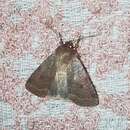Biology
provided by Arkive
Adults of this single-brooded moth fly in July and August. The caterpillars are present from September to May (2) feeding on bilberry and ling at first, but progressing to young leaves on low branches of small birch trees after the over-wintering period (1).
Conservation
provided by Arkive
The Species Action Plan produced for the Cousin German moth as part of the UK Biodiversity Action Plan (UK BAP) aims to maintain the present range of the species. Some populations are located within existing Sites of Special Scientific Interest (SSSIs) and nature reserves. Conservation action targeted at other threatened species that occur within Scottish pine forests, such as the Scottish wood ant Formica aquilonia, will also benefit the Cousin German moth (1).
Description
provided by Arkive
Cousin German (Protolampra sobrina, formerly known as Paradiarsia sobrina) is a rare moth that has dark brown forewings with a purplish tinge and paler hind-wings, which become darker towards the outer margins (3).
Habitat
provided by Arkive
Inhabits birch woods and old Caledonian pine forests, where there are large spaces between individual trees (1) and a ground layer of bilberry (Vaccinium) (4).
Range
provided by Arkive
Known from a just few locations in the central Scottish Highlands. It has been mostly recorded in Rannoch and Aviemore and less frequently from Strathspey and the Dee Valley (1).
Status
provided by Arkive
Classified as Rare in Great Britain (1).
Threats
provided by Arkive
This species has suffered as a result of burning and unsuitable grazing regimes in the birch and pinewood pastures it inhabits (1). As a northern moth, global warming is a long-term threat (4).

